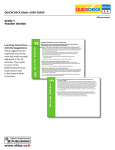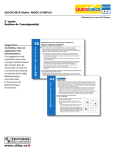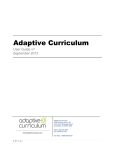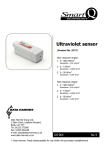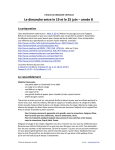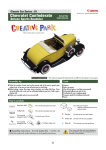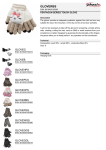Transcript
Quickcheck Math: user guide Geometry and Spatial Sense Grade 3 Teacher Section Learning Connection Activity Suggestions: These suggestions are organized around the same key math concepts addressed in the 24 activities. They relate to some of the Mathematical Process Expectations used in the Ontario Math Curriculum. 26 T e a c h e r S e c T i o n Learning connection activity suggestions Mathematical process expectations: reflecting, connecting, and communicating n Describe relationships between two-dimensional shapes, including congruence Use the following activities to give students the opportunity to create and describe polygons using geometric properties and to differentiate between specific examples of polygons that belong to the same category. Use geoboards or paper and pencil to create the following. — A quadrilateral that has only one pair of parallel lines. Ask: “What is this shape called?” (Trapezoid.) Say: “Make a shape that is congruent to the one you just made.” — Two quadrilaterals with two pairs of parallel lines. Ask: “What else could you call these shapes?” (Parallelogram.) — A polygon with only two right angles. Ask: “What is this shape called?” (Pentagon.) Say: “Now make a different pentagon. How do you know that it is a pentagon?” (Five sides; five interior angles.) — Two different rhombuses. Ask: “Is a rhombus a quadrilateral? A parallelogram? How do you know?” — Say: “Describe a polygon to your partner and see if he/she can make it!” n relate two-dimensional shapes to three-dimensional figures, including naming prisms and pyramids by the shape of their bases Have students use toothpicks and Plasticine to build a three-dimensional figure. Using the number and shape of faces, students describe their figure to a partner so that the partner can make it without seeing it. challenge: n investigating prisms 3m48-EN.indd 51 T e a c h e r S e c T i o n 1. Say: “Look at two different prisms. Count the number of sides of the base and record the number. Now count the number of faces and record it. Repeat this with a different prism. Is there a pattern? What do you notice?” 2. Try the activity above using a square and triangle-based pyramid. Ask: “Is there a pattern, the same as for prisms?” n Describe the locations and movements of shapes and objects eg. 1. Plot three or four familiar locations on an 8 X 8 grid (see example at right). 2. Ask students to show travel routes on the lines of the grid and then describe the movement from one location to another. school park — Ask: “What is the total number of squares travelled? Could you show a shorter route?” — Say: “Plot a new location on the grid that is the same distance away from home and school. How do you know that it is the same distance away? Describe its location as it relates to home and to school.” 3m48-EN.indd 52 12-09-14 10:49 The following two questions give students the opportunity to investigate the relationship between the number of sides of the base and the total number of faces in a prism. Help students make the connection between the number of sides of a prism’s base and the number of faces in that prism (number of faces = number of sides of the base shape + 2). The emphasis here is on investigating and describing the relationship, not on memorizing a formula. home 12-09-14 10:49
